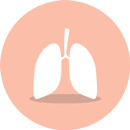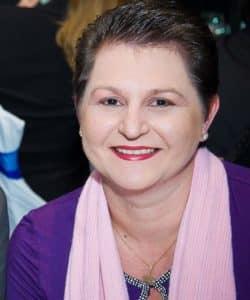
Lungs

Some people with TSC (Tuberous Sclerosis Complex), especially women, may have signs of TSC in their lungs.
The most common sign is lymphangioleiomyomatosis (LAM). Most of these people will not have any symptoms but it is still recommended for all women to have a scan of their chest to look for signs of TSC in their lungs.
Terms used by health professionals for things to do with the lungs are respiratory and pulmonary. Doctors who specialise in lungs and lung disease are called respiratory physicians, or pulmonolgists in the USA.
Signs, Symptoms and
Treatments
Signs and Symptoms
Signs of TSC in the lungs are much more commonly found in women and usually only in adulthood. There have only been a very small number of cases of TSC affecting the lungs in men.

The lungs can be affected by TSC in two different ways:
- Lymphangioleiomyomatosis (LAM)
- Multifocal micronodular pneumocyte hyperplasia (MMPH)
People with TSC can be affected with many other lung diseases, just like everyone else in the community. These include infections such as influenza and pneumonia as well as asthma.
Lymphangioleiomyomatosis (LAM) is a lung disease that affects exclusively women, usually between the onset of puberty and menopause. LAM has also been reported in older women with TSC, but it is not clear when the disease developed in these individuals.
It is hard to estimate the number of women with TSC who have LAM. Some studies have found 30-40% of women with TSC also have LAM, but only 4% of women with TSC will show symptoms of LAM. Some researchers think that all women with TSC will develop signs of LAM in their lungs, but only a small number will ever have symptoms.
When a person has LAM, an unusual type of muscle cell (the LAM cell) is found in their lungs, airways, and blood and lymph vessels. Over time, these muscle cells destroy the lungs and make it difficult for oxygen to get across the wall of the airway and into the blood cells. This prevents the lungs from providing oxygen to the rest of the body.
The word lymphangioleiomyomatosis can be broken down into its parts to help explain what the disease is. Lymph- and angio- refer to the lymphatic and blood vessels in the body, respectively. The lymph nodes and lymphatic vessels are involved in the lung, and the cysts that form in the lung may contain lymph fluid. Leiomyomatosis refers to the presence of the unusual muscle cells in the lung which spread into the lung substance.
Pulmonary LAM has a distinctive appearance. The lungs of a person with TSC who has LAM contain many cysts, varying in size from a few millimeters to several centimeters. These cysts take the place of the normal fine lacy pattern of the normal lung. The cysts are usually empty, but they may contain lymph fluid, referred to as chylous fluid. The walls of the person’s airways become infiltrated with muscle cells, and become thickened and distorted, resulting in cyst formation. Also, blockage of the lymphatic vessels can result in leakage of lymphatic fluid into the space between the lungs and the chest wall (pleural effusion).
You may also like to watch this video by Dr Helen Whitford or refer to this booklet from LAM Australia.
Most women with TSC and LAM never have symptoms. For a smaller proportion, LAM can be a disease that gradually worsens.
Single cysts in the lungs may rupture, which can cause a collection of air or gas in the space surrounding the lungs. This is a very serious condition called pneumothorax or lung collapse. This may lead to abnormal or uncomfortable breathing for that person, which is called breathlessness or dyspnoea. It may also lead to coughing up blood from the respiratory tract, a condition called haemoptysis.
Multiple cysts in the lungs can be a sign of severe LAM. Sometimes the lungs cannot take in sufficient oxygen or expel sufficient carbon dioxide to meet the needs of the cells of the body. Doctors call this respiratory insufficiency. The person may also rarely be diagnosed with pulmonary hypertension (PHT). This is high blood pressure in the arteries that supply blood to the lungs. Once PHT has been diagnosed, often more medical care is needed, including regular follow-up with a respiratory physician or a cardiologist specializing in caring for individuals with PHT.
Some people have LAM without having TSC and this is called sporadic LAM, or S-LAM. When LAM is diagnosed in a person with TSC, health professionals refer to this as TSC-LAM.
Some people with sporadic LAM also have kidney tumours, but few other signs of TSC.
Researchers have identified mutations in the TSC2 gene in individuals with sporadic LAM, indicating that LAM is caused by mutations in the same gene(s) as TSC.
The number of individuals who have LAM is not known. Scientists estimate that there may be up to 300,000 women with the disease worldwide if both individuals who have TSC-LAM and sporadic LAM are included.
Multifocal micronodular pneumocyte hyperplasia (MMPH) consists of overgrowth (hyperplasia) of the pneumocytes (a specific type of cell found in the lining of the air sacs in the lung) into small nodules. An individual with TSC who has MMPH may have a few or many nodules in their lungs. This condition occurs with equal frequency in men and women with TSC and does not usually produce any symptoms or cause any problems. MMPH does not spread and the main problem with this is that it may be misdiagnosed as something else in a person with TSC, causing unnecessary investigations and anxiety. MMPH responds to treatment with reduction in the size of the nodules.
The following topics are covered separately:
Lung Surveillance
Surveillance is important because it can lead to early detection and treatment. Each person with TSC should have an individual management plan developed with their medical team that uses these guidelines as a starting point.
- Evaluation of symptoms of LAM (unexplained cough, chest pain, shortness of breath or breathing difficulties) should occur at each clinical visit.
- Females aged 18 years and over should have a high resolution chest computerized topography (HRCT) scan to look for signs of LAM. This should also include adult males only if symptomatic. If lung cysts are detected, HRCT should be repeated every 2-3 years; otherwise every 5-10 years.
- Pulmonary function tests and sometimes a 6-minute walk test should be performed in all females aged 18 years and over and in adult males who have symptoms. If lung cysts are detected by HRCT this should be repeated annually.
It is recommended that females seek advice from a doctor with experience in TSC before commencing the oral contraceptive pill or planning a pregnancy. This is because doctors believe that oestrogen might make LAM worse. However, treatment with low dose oral contraceptives is not always contraindicated.
It is important to avoid tobacco smoke, vaping and exposure to second-hand smoke or vapes. No one with LAM should smoke.

The diagnosis of the lung features of TSC can be difficult because many of the early symptoms are similar to those of other lung diseases such as asthma, emphysema, or pulmonary bronchitis. The first signs of LAM are chest pain and shortness of breath, which may occur with a pneumothorax, but many individuals with TSC who are diagnosed with LAM will be completely free of any symptoms.
There are a number of tests that doctors can do to diagnose LAM in TSC:
- Computed tomography: High resolution computed tomography (HRCT) is the most useful imaging test for diagnosing LAM or MMPH in individuals with TSC. The presence of thin-walled cysts and/or nodules can be observed using a CT scan of the lungs. HRCT is easy nowadays and takes only about 90 seconds in a scanner.
- Chest X-ray: This is a simple procedure that produces a picture of the lungs and other tissues in the chest. The chest x-ray is used to diagnose a pneumothorax or the presence of fluid in the chest cavity. However, the cysts that are suggestive of LAM can be difficult to see on a chest x-ray, so a CT scan is often used instead.
- Lung function tests: To perform lung (or respiratory) function tests (RFTs), the individual breathes through a mouthpiece into a spirometer and other equipment. A spirometer is a machine that measures the volume of air in the lungs, the movement of air into and out of the lungs. The movement of oxygen from the lungs into the blood is checked by other tests. These tests can be used to determine the effects that lung involvement in TSC have on lung performance over time, but cannot be used to make a diagnosis. More sophisticated lung function tests will pick up earlier disease and can be useful for measuring change.
- Blood tests: A blood sample from the individual with TSC is analysed to determine whether the lungs are providing an adequate supply of oxygen to the blood. This is also a useful test to use to follow the progression of LAM in individuals with TSC.
- Thoracoscopy and video-assisted (VATS) thoracoscopic biopsy: Thoracoscopy is used to obtain lung tissue. In this procedure, tiny incisions are made in the chest wall and a small lighted tube (endoscope) is inserted so that the interior of the lung can be viewed, and small pieces of tissue removed. This procedure is done in a hospital under general anaesthetic. Recovery from thoracoscopy is usually quicker than with the more invasive lung biopsy.
- Open lung biopsy: An open lung biopsy is nowadays only performed as a last resort to diagnose LAM, if there are good reasons why a less invasive procedure is not safe. In this procedure, a few small pieces of lung tissue are removed through an incision made in the chest wall between the ribs. This procedure must be done in the hospital under general anaesthetic.
- Transbronchial biopsy: This procedure can be used to obtain a small piece of lung tissue through a long, narrow, flexible, lighted tube (bronchoscope) that is inserted down the trachea (windpipe) and into the lungs. Bits of lung tissue are sampled using tiny forceps. This procedure is done in a hospital on an outpatient basis under local anesthetic. However, the amount of tissue that can be sampled is often inadequate for diagnostic purposes in individuals with LAM. Other tests (eg cryobiopsy) are used in other lung diseases but not usually in LAM, where there is a high risk of collapsed lung (or pneumothorax).
The symptoms of LAM, such as lung collapse, fluid in the lungs, shortness of breath and chest pain can also aid in the diagnosis of LAM or other lung signs of TSC.
Researchers are exploring other tests that may help diagnose LAM. These tests include blood tests for the LAM cells or a blood vessel growth factor called VEGF-D.
Treatment
Severe LAM is a serious illness, but treatment is available and helps with preventing the gradual lung decline which may occur. There is a large amount of ongoing research identifying and trialling new treatments for LAM.
Most treatments for LAM are aimed at easing symptoms and preventing complications. The main treatments are:
- mTOR inhibitor medicines
- Medicines to improve air flow in the lungs and reduce wheezing
- Oxygen therapy
- Procedures to remove fluid from the chest or abdomen and stop it from building up again
- Hormone therapy
- Lung transplantation
Each individual with LAM will work with their doctor to decide the best treatments for them.
Vaccinations for influenza and pneumonia should also be considered because these infections can be very serious in individuals with LAM. COVID vaccination is safe for individuals with LAM but information about specific vaccines should be obtained from your GP. Supplemental oxygen during air travel and avoiding low oxygen environments such as high altitude and unpressurised aeroplane cabins may also be recommended for some individuals with LAM.
Everolimus (Afinitor) and Sirolimus (rapamycin) are new medicines that have been trialled for the treatment of TSC and LAM.
Everolimus has been approved by the Pharmaceutical Benefits Scheme (PBS) in Australia to treat patients with TSC/LAM. In the USA the Food and Drug Administration (FDA) approved Sirolimus for the treatment of LAM in 2015.
Despite the lack of formal approval in Australia, respiratory specialist doctors will consider prescribing an mTOR inhibitor to treat LAM. This is called “off-label” use. In this situation a hospital may provide funding for the medication.
Read more about mTOR inhibitor medicines.
Researchers believe that oestrogen may play a part in LAM. This means that doctors usually recommend that women with LAM avoid oestrogen containing oral contraceptive pills, and post menopausal hormone replacement therapy. Women with LAM should also discuss a possible pregnancy with their doctor as the hormones produced during pregnancy might worsen LAM. Pregnancy can be contemplated but should be carefully planned and advice from an expert in LAM as well as an interested obstetrician is usually best before having a baby.
Last updated: 12 December 2022
Reviewed by: Professor Deborah Yates, Respiratory Physician, St Vincent’s Hospital, Holdsworth House Medical Practice and UNSW
- Kwiatkowski D.J., Whittemore V.H. & Thiele E.A. (2010) Tuberous Sclerosis Complex: Genes, Clinical Features, and Therapeutics. Weinheim: Wiley-Blackwell
- Lung Involvement in TSC, Tuberous Sclerosis Alliance, viewed 6th April 2012, https://tsalliance.org/pages.aspx?content=593
Parts of this web page have been adapted with permission from copyrighted content developed by the TSC Alliance (tscalliance.org)
